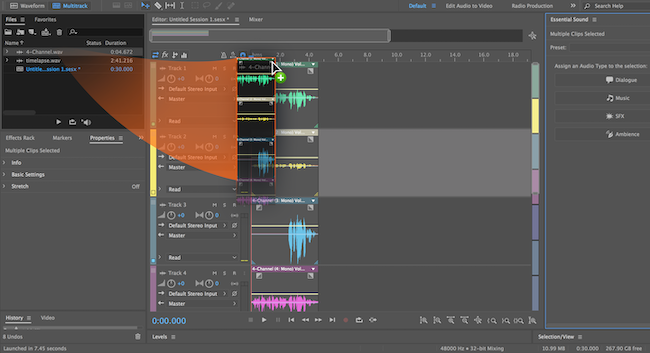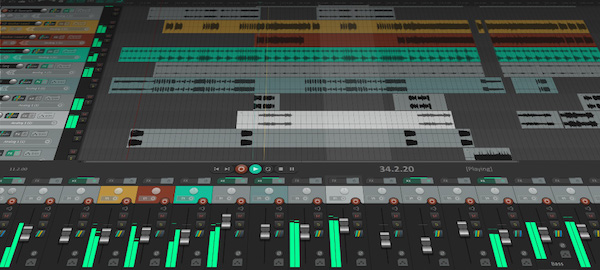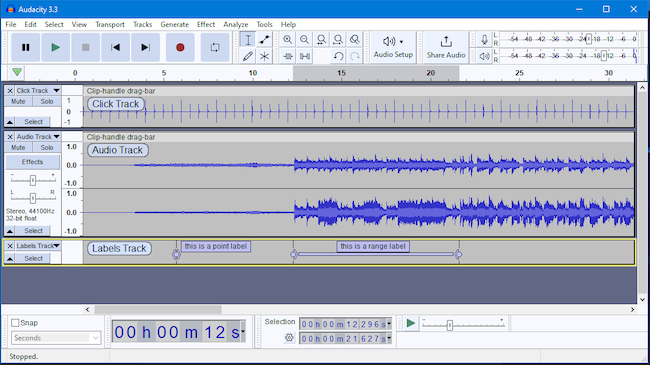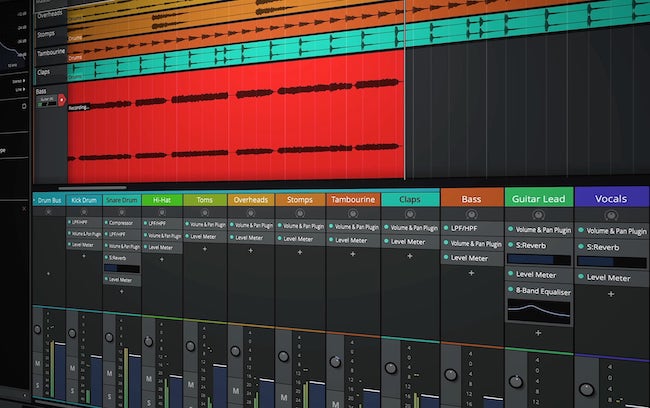GarageBand is a digital audio workstation (DAW) software developed by Apple Inc. It is designed for macOS and iOS devices and is widely regarded as one of the most popular and user-friendly music production software available. The software comes with an intuitive and visually appealing interface. It has a diverse collection of virtual instruments and a vast library of pre-recorded loops. It also seamlessly integrates with other Apple applications and lets users import and export music to iTunes, iMovie, or share directly to Apple Music or SoundCloud. The only issue with GarageBand is that it is exclusive to Apple’s operating systems. So, Windows users cannot directly access it. People who want to use GarageBand need to look for similar alternatives. Musicians, producers, or audio enthusiasts who use Windows-based systems for various reasons look for a good GarageBand alternative for Windows. If you also want a good GarageBand alternative, keep reading. In this article, I am making a list of the best GarageBand alternatives for Windows.
Also see: Best Free Audio Splitter Software for Windows
GarageBand alternative for Windows
1. Adobe Audition
Adobe Audition is a powerful and popular music production software used by musicians, audio engineers, and producers to create, edit, and enhance audio tracks. It offers a range of features that make it an essential tool for anyone working on music or audio projects.
Adobe Audition comes with a user-friendly interface that makes it accessible to both beginners and experienced professionals. The software provides a multitrack editing environment. So, users can work on multiple audio files simultaneously. This makes it easy to arrange different elements of a song, like vocals, instruments, and effects, on separate tracks for precise control.
Adobe Audition offers several tools and effects. You can cut, trim, and merge audio clips, adjust volume levels, and apply various filters and effects to fine-tune the sound. One remarkable feature of Adobe Audition is its spectral editing capability. This allows users to visualize the frequency content of an audio clip and perform detailed edits on specific frequencies.
Adobe Audition also has a robust recording interface that supports multi-channel recording. Whether you are recording vocals, live instruments, or MIDI, the software ensures high-quality audio capture. Additionally, its automatic audio alignment feature simplifies the process of synchronizing multiple audio tracks.
Another advantage of Adobe Audition is its seamless integration with other Adobe products like Adobe Premiere Pro, allowing for a smooth workflow when combining audio and video elements for multimedia projects.
Furthermore, Adobe Audition supports a wide range of audio file formats, making it versatile for handling various audio assets. Once you’re done with your project, you can easily export your work in different formats suitable for the web, CDs, or other platforms.
| Pros | Cons |
|---|---|
| – Professional-grade software with powerful tools | – Subscription-based pricing model can be costly |
| – User-friendly interface for both beginners and experts | – Steeper learning curve for new users |
| – Spectral editing for precise audio manipulation | – May require high system resources for smooth use |
| – Seamless integration with other Adobe products | – May be overwhelming for basic audio editing needs |
- Platform Availability: Windows, macOS
- Pricing: Adobe Audition is not free and is available through Adobe Creative Cloud subscription plans. Adobe offers various subscription options, including a single app plan for Adobe Audition or a complete suite plan with access to multiple Adobe software.
2. Reaper
Reaper is another widely-used music production software that comes with powerful tools that allow users to create, edit, and mix audio with ease. One of the great things about Reaper is its customizable interface. Users can customize the layout and design of Reaper to suit their preferences and workflow. This flexibility makes it appealing to both newcomers and experienced professionals in the music industry.
Reaper provides a multi-track environment where users can work on multiple audio tracks simultaneously. This makes it convenient to arrange different elements of a song or audio project, like vocals, instruments, and effects, on separate tracks for better control and organization. Users can perform various editing tasks such as cutting, trimming, and merging audio clips effortlessly. Adjusting volume levels, applying fades, and adding various audio effects are also straightforward. These tools and options allow for precise and creative editing.
One standout feature of Reaper is its extensive support for third-party plugins and virtual instruments. This means users can expand the software’s capabilities by integrating external plugins and virtual instruments into their projects. Whether it’s virtual synthesizers, effects processors, or audio processors, Reaper can handle them all.
Reaper also supports multi-channel recording, making it suitable for capturing live performances or recording multiple instruments simultaneously. Users can also record MIDI data, which is handy for producing electronic music or working with virtual instruments.
Reaper also boasts a powerful automation system. This enables users to automate various parameters in their audio tracks, like volume, panning, and effects settings. Automation helps create dynamic changes in the music without having to manually adjust settings throughout the entire track.
In addition to its music production capabilities, Reaper is known for its exceptional performance and efficiency. It is lightweight software that doesn’t require excessive system resources, making it run smoothly even on less powerful computers.
Reaper is continually updated and well-supported, with an active community of users who share tips, tutorials, and resources. This fosters a collaborative environment where users can learn from each other and improve their music production skills.
| Pros | Cons |
|---|---|
| – Highly customizable interface to suit user preferences | – Interface design may feel less polished |
| – Extensive support for third-party plugins and instruments | – Features and tools may require plugin integration |
| – Efficient and low-latency performance | – Can be overwhelming for absolute beginners |
| – Strong audio and MIDI editing capabilities | – Limited built-in virtual instruments |
- Platform Availability: Windows, macOS, Linux
- Pricing: Reaper offers a flexible pricing model. Users can download and evaluate the software for free without a time limit. However, if users decide to continue using it after the evaluation period, they are expected to purchase a license. Reaper’s license pricing is much more affordable compared to many other DAWs, making it a popular choice for budget-conscious users.
3. Cakewalk by BandLab

Cakewalk by BandLab is also a good music production software used by musicians, composers, and audio professionals. The software comes with several impressive features and a user-friendly interface that cater to both beginners and experienced users.
Cakewalk by BandLab comes with advanced digital audio workstation (DAW) capabilities. It provides a multi-track environment where users can work on audio and MIDI tracks simultaneously. It enables easy arrangement and organization of vocals, instruments, and effects to create complete compositions.
Cakewalk offers a variety of editing tools for refining audio recordings and MIDI sequences. Cutting, trimming, and merging audio clips is easy and it ensures precise edits. The software also allows MIDI quantization, correcting the timing of recorded performances for tight and accurate arrangements. Users also have creative tools to enhance their tracks. Realistic virtual synthesizers and diverse audio effects add depth to the sound.
Cakewalk’s reliable interface supports multi-channel recording for live performances or multiple instruments. Mixing and mastering capabilities of the tool are commendable. Users can easily adjust volume levels, pan positions, and apply various audio effects for a professional mix. Automation features bring dynamics and movement to the music.
Cakewalk by BandLab also offers a seamless collaboration option with its cloud-based system. It enables users to share projects and receive feedback from others.
Cakewalk is available for free, making it an attractive option for budget-conscious users or those exploring feature-rich DAWs without financial commitment.
| Pros | Cons |
|---|---|
| – Feature-rich DAW with multi-track environment | – Some features may require advanced technical know-how |
| – User-friendly interface and accessibility | – Limited official technical support |
| – Extensive virtual instruments and effects | – May not have all the features of paid software |
| – Cloud-based collaboration for easy sharing | – Some users may prefer other DAWs |
- Platform Availability: Windows
- Pricing: Cakewalk by BandLab is available for free. BandLab acquired the software and made it completely free for users, allowing musicians to access professional-grade features at no cost.
4. Audacity
Audacity is a popular and user-friendly audio editing and music production software that has gained a strong reputation in the audio community. It is an open-source program, so it is continuously improved by a community of developers and enthusiasts. One of the key advantages of Audacity is its simplicity and ease of use. Whether you are a beginner or a seasoned professional, you will find it easy to use with its intuitive interface. This makes it a great choice for those just starting with music production or audio editing.
Audacity provides a multi-track environment where you can work on multiple audio tracks simultaneously. This is especially handy when creating complex audio projects, such as mixing songs or adding multiple audio elements to a podcast or video. The software allows you to edit audio with a range of tools. You can cut, copy, paste, and delete audio segments, as well as adjust volume levels and apply various effects like fade-ins, fade-outs, or equalization. These basic editing features enable you to refine your audio recordings and create a polished sound.
Audacity supports a variety of audio file formats, making it versatile for importing and exporting audio files. This means you can work with different types of audio files and easily share your projects with others.
Audacity also has the ability to record audio directly from your computer’s microphone or line input. This makes it useful for recording voiceovers, podcasts, or capturing live performances. I also use Audacity to record voiceovers for my YouTube videos.
Audacity also supports real-time audio recording and editing. This means you can hear the changes you make to your audio tracks immediately, allowing for quick experimentation and adjustments. While Audacity is known for its simplicity, it also offers advanced features that can be valuable for more experienced users. For instance, it supports audio manipulation through the use of plugins. Users can install various third-party plugins to expand Audacity’s functionality and access additional effects and tools.
However, it is worth noting that Audacity may lack some of the advanced features found in more professional-grade software. For complex music production tasks, some users might eventually outgrow Audacity and seek more sophisticated tools.
| Pros | Cons |
|---|---|
| – Free and open-source, suitable for budget-conscious users | – Basic interface with limited advanced features |
| – Easy-to-use, especially for basic audio editing tasks | – Lacks some advanced audio production capabilities |
| – Support for various audio file formats | – No native virtual instruments or effects |
| – Recording audio directly from microphone or line input | – No real-time collaboration features |
- Platform Availability: Windows, macOS, Linux
- Pricing: Audacity is an open-source software and is available for free. Being open-source, it is freely accessible to all users without any subscription or licensing fees.
5. Waveform Free
Waveform Free is a music production software that offers powerful features and capabilities. This software can also be used by musicians, producers, and audio enthusiasts for creating music. The software is user-friendly and provides professional-level tools for creating and editing music.
Waveform is available for free. So, it is an excellent option for beginners who are not in the condition of purchasing professional software. Despite being free software, Waveform Free does not compromise on quality. It offers a multi-track environment where users can work on various audio and MIDI tracks simultaneously. This makes it easy to arrange different elements of a song, such as vocals, instruments, and effects, for a complete and polished composition.
The software includes a wide range of editing tools that allow users to fine-tune their audio recordings and MIDI sequences. Cutting, trimming, and merging audio clips can be done with precision, ensuring seamless edits. The MIDI editing capabilities are also robust, enabling users to adjust note velocities, lengths, and positions to create dynamic and expressive musical performances.
Waveform Free comes with a good selection of virtual instruments and audio effects. These built-in tools provide users with creative options for enhancing the sound of their tracks. Whether you need realistic virtual synthesizers or audio processors to add unique effects, Waveform Free has you covered.
It supports multi-channel recording, making it suitable for capturing live performances or recording multiple instruments simultaneously. The software ensures low-latency performance, resulting in high-quality recordings with minimal delay. Mixing and mastering in Waveform Free is a breeze. Users can adjust volume levels, pan positions, and apply various audio effects to each track, allowing for a professional-sounding mix. The automation feature also allows users to create dynamic changes in their music over time, adding movement and interest to their compositions.
Waveform Free has a supportive community of users, and its developers frequently update the software with new features and improvements. This ensures that users have access to the latest tools and advancements in music production.
| Pros | Cons |
|---|---|
| – Available for free, great for budget-conscious users | – May lack some advanced features |
| – Multi-track environment for complex music projects | – Limited virtual instruments and effects |
| – Robust editing tools for audio and MIDI | – Free version may have limitations |
| – Supportive community with regular updates |
- Platform Availability: Windows, macOS, Linux
- Pricing: Waveform Free, developed by Tracktion Corporation, is a free version of their Waveform DAW. It offers a substantial set of features and is available at no cost, making it an attractive option for those looking for a free DAW.










